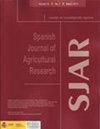Zinc and phosphorus availability to wheat as affected by humic substances in calcareous and siliceous growth media
IF 0.8
4区 农林科学
Q3 AGRICULTURE, MULTIDISCIPLINARY
引用次数: 0
Abstract
Aim of study: Humic substances (HS) have an impact on the dynamics of phosphorus (P) and zinc (Zn) in soil and consequently can affect the availability of both nutrients to plants. This work aimed to study the effect of humic substances on the availability of P and Zn to wheat depending on the main sorbent surfaces in growth media. Area of study: Growth chambers of the Higher Technical School of Agricultural Engineering, University of Seville, Spain Material and methods: To this end, a pot experiment was performed involving three factors: i) HS rates, ii) Zn fertilization, and iii) type of growth medium, calcareous and noncalcareous (siliceous). Main results: Biomass production and Zn uptake by plants decreased with increasing HS rates. Humic substances decreased zinc uptake more markedly in the siliceous medium. Negative effects of HS can be ascribed to altered crop nutrition and the high aromaticity of HS that can promote phytotoxic effects. The antagonistic effect between P and Zn was less evident in the calcareous medium than in the siliceous medium. This is probably explained by the reduced availability of Zn and the consequent decrease in uptake by plants in the calcareous medium compared to the siliceous medium. These differences observed between both media can be ascribed to different adsorption dynamics depending on the main sorbent surfaces. Research highlights: The addition of HS, at the intermediate rates studied, had a positive effect on the microbial activity of the rhizosphere in the calcareous medium. Thus, not only crop functioning, but also soil biology, can be affected by the application of HS. This effect can be different depending on the HS rates applied and the type of growth medium.钙质和硅质生长介质中腐殖质物质对小麦锌磷有效性的影响
研究目的:腐殖物质(HS)影响土壤中磷(P)和锌(Zn)的动态,从而影响植物对这两种营养物质的有效性。本工作旨在研究腐殖物质对小麦磷和锌有效性的影响,这取决于生长介质中的主要吸附剂表面。研究领域:西班牙塞维利亚大学农业工程高等技术学院的生长室材料和方法:为此,进行了一项盆栽实验,涉及三个因素:i)HS率,ii)Zn施肥,以及iii)生长介质类型,钙质和非钙质(硅质)。主要结果:随着HS速率的增加,植物的生物量产量和锌吸收量下降。腐殖物质在含硅介质中更显著地降低了锌的吸收。HS的负面影响可归因于作物营养的改变和HS的高芳香性,可促进植物毒性作用。磷和锌在钙质介质中的拮抗作用不如在硅质介质中明显。这可能是由于与硅质培养基相比,钙质培养基中锌的可用性降低,以及植物对锌的吸收减少。在两种介质之间观察到的这些差异可归因于取决于主要吸附剂表面的不同吸附动力学。研究重点:在所研究的中间速率下,HS的添加对石灰介质中根际的微生物活性产生了积极影响。因此,HS的应用不仅会影响作物功能,还会影响土壤生物学。这种效果可能会有所不同,这取决于所应用的HS速率和生长培养基的类型。
本文章由计算机程序翻译,如有差异,请以英文原文为准。
求助全文
约1分钟内获得全文
求助全文
来源期刊

Spanish Journal of Agricultural Research
农林科学-农业综合
CiteScore
2.00
自引率
0.00%
发文量
60
审稿时长
6 months
期刊介绍:
The Spanish Journal of Agricultural Research (SJAR) is a quarterly international journal that accepts research articles, reviews and short communications of content related to agriculture. Research articles and short communications must report original work not previously published in any language and not under consideration for publication elsewhere.
The main aim of SJAR is to publish papers that report research findings on the following topics: agricultural economics; agricultural engineering; agricultural environment and ecology; animal breeding, genetics and reproduction; animal health and welfare; animal production; plant breeding, genetics and genetic resources; plant physiology; plant production (field and horticultural crops); plant protection; soil science; and water management.
 求助内容:
求助内容: 应助结果提醒方式:
应助结果提醒方式:


